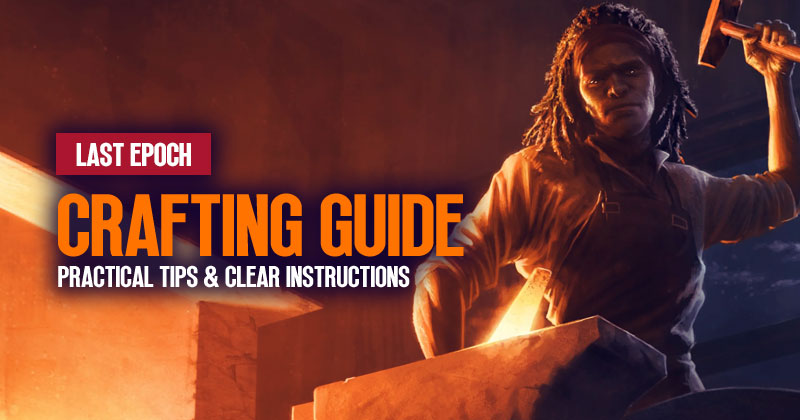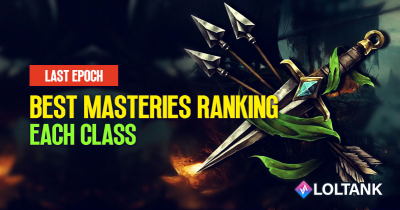Last Epoch Crafting Guide: Practical Tips and Clear Instructions
- Dwight
- Share
- Last Epoch
- 02/16/24
- 2262
Crafting is an integral part of the character development process in Last Epoch, not just a side activity. Understanding this crucial information could be that one thing that moves your character from being an average player to being among the best players in this role-playing game. The main purpose of this inclusive guide is to provide all necessary basics, advanced strategies are also dwelling on as well as helping you be a master-crafter at Last Epoch.

↖ Starting with Craft
It is possible for any normal, magic, rare or exalted item to have forging potential enabling them to be crafted except unique ones or set items. Each item in the game has a limited number of affixes; the more powerful an item's affixes are, the fewer there are of them.
Item Level (which is indicated by Roman numerals) represents a measure of power for each tier within an affix category. This means that if someone says "tier 20" they mean that it's made up entirely of tier five modifiers—a near perfect item. At this stage, all what you need during endgame loops is finding good bases and using shards plus glyphs/rune/smithing tools on it to make godly gears.
↖ Craft During Campaign
Usually during your first time crafting experiences you'll find yourself somewhere within a campaign mode where resources abundant and mistakes cost nothing yet. So what should I do? In fact, it doesn’t take rocket science! One needs only concentrate on boosting damage done by weapons; enhancing lives/resists with armors and adding movement speed for boots. For the more significant endgame items you will have to save the rarer shards.
↖ Glyphs and Runes
Crafting in Last Epoch involves two other elements that are runes and glyphs. Here is a quick overview:
- Glyph of Hope: Gives a chance not to consume any forging potential during crafting.
- Glyph of Chaos: Randomly changes an affix when upgrading, but use it cautiously as it can make or break an item.
- Glyph of Order: Preserves the percentile range when upgrading an affix—ideal for maximizing specific stats.
- Glyph of Despair: Seals (or attempts to seal) an affix so it can't change further; more effective on lower-tier affixes.
At various points in mapping, There are serval better use cases for different kinds of runes
- Rune of Shattering: Breaks down items into Aex shards.
- Rune of Refinement: Rerolls all values within their current tiers on all prefixes and suffixes randomly.
- Rune of Removal: Eliminates one affix , the result is giving out shards equal to that tier.
- Rune of Discovery: Adds random tier-one affixes to all empty slots on the item being crafted,
- Runeof Shaping: Rerolls implicit modifiers (i.e., attributes or abilities that come with a specific item class).
- Runeof Ascendance: Changes unique/set items (depending on what's allowed by class) into rare ones instead where each new item has its own forged potential while also nullifying the forged potential on both items.
Combine an exalted item with full affix slots with a unique item that has legendary potential in Temporal Sanctum, to craft a legendary object. The sanctum's level requirement depends on the unique item's level requirement.
This process transfers one random modifier from the exalted item onto the unique item, in addition to its existing stats. The number of modifiers transferred corresponds to the unique items' legendary potential (LP). Four LP items are very rare but offers the best potential outcomes.
↖ Practical Crafting Tips
- Start from scratch: Identify items that have high levels of forging and highly desirable static or suffix properties.
- Focus on critical statistics: Begin by upgrading crucial suffixes like damage and resistance.
- Save on resources: Use spells such as Glyph of Hope to cut down any possible losses experienced during crafting.
- Know when to quit: Always think about shattering the object if it is not worth it due to poor prefix rolls or low forging potential.
Conclusion
The last epoch has allowed for crafting as a system which is richly rewarding and allows for huge customization, power growth your character will ever experience. It can be extremely satisfying regardless of whether you are a new player or an old one plunged into this part of the game for the first time. In Eterra, you will have gear that is not only tailored towards your build but also helps you reach greater heights when properly crafted with enough practice and patience.
Most Popular Posts
- Last Epoch Weaver's Will: Everything You Need To Know
- Last Epoch New Uniques and Weaver's Will Item in Rising Flames | Patch 0.9.1 Updates
- Last Epoch Review: Should You Buy and Play It In 2023?
- Last Epoch Guide: Creation Character, Masteries, Skill Previews, and More
- Last Epoch Dev Stream Highlights: Teasers, Corruption Updates, 1.0 Release, and Factions
- Last Epoch Beginner Guide: 8 Essential Tips for a Successful Start
Popular Category Lists
- Path of Exile / (873)
- Diablo IV / (702)
- Runescape / (344)
- New World / (172)
- WoW Classic SoD / (171)
- Guild Wars 2 / (159)
- Elder Scrolls Online / (138)
- FFXIV / (135)
- World of Warcraft / (65)
- WOW Classic / (43)
- Elden Ring / (40)
- Throne and Liberty / (36)
- SWTOR / (35)
- Albion / (35)
- Last Epoch / (32)
- League of Legends / (30)
- Dark and Darker / (28)
- Fallout 76 / (27)
- WotLK Classic / (23)
- Genshin Impact / (22)





 0
0








